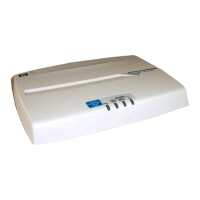6-9
Wireless Interface Configuration
Configuring the Radio
To support both 802.11g and 802.11b stations, the access point must first
communicate with all stations using CCK and only switch to OFDM for data
transfers between 802.11g-compatible stations. This mechanism has the effect
of reducing the maximum throughput for 802.11g stations in the network.
Working in its mixed “b/g” mode, the access point experiences reduced data
throughput, even if there are no 802.11b stations active in the network. To
achieve a higher throughput, you can set the access point to operate in 802.11g
mode, which ignores all 802.11b stations in the service area.
Note If both Radio 1 and Radio 2 are set to the IEEE 802.11b/g mode, Radio 2 must
be configured to an external antenna. See
“Modifying Antenna Settings” on page 6-23.
Note Both the IEEE 802.11g and 802.11b standards operate within the 2.4 GHz band.
In a wireless LAN environment, there can often be interference from other
2.4 GHz devices, such as cordless phones. If you experience poor wireless
LAN performance, try to limit any possible sources of radio interference
within the service area.
Web: Setting the Radio Working Mode
The Network Setup – Radio screen, shown in Figure 6-1, enables you to set
the access point’s radio working mode.
Note If you are using the worldwide product (J8987A), you must set the country
code, using the CLI, before you can configure the radio settings. See
“Setting
the Country Code” on page 6-4
. Use the write mem command to save the setting.
The Web interface enables you to modify these parameters:
■ Radio: Allows toggling to either Radio 1 or Radio 2 parameter sets. (The
default is Radio 1.)
■ Status: Allows enabling/disabling of the respective radio. If the radio is
enabled, the following fields become available for modification. (The
default is Disabled.)
■ Mode: Selects a standard operating mode for the access point. If both
Radio 1 and Radio 2 are set to the IEEE 802.11b/g mode, Radio 2 must be
configured to an external antenna. See
“Modifying Antenna Settings” on page 6-
23
.
• IEEE 802.11b: Stations communicate in a data transfer range
between 1 to 11 Mbps. This standard uses direct sequence spread
spectrum (DSSS) or frequency hopping spread spectrum (FHSS) in
the 2.4 GHz ISM band as well as CCK to provide the higher data rates.

